#lesser bushbaby
Text
Lesser Galago / Bushbaby on its nightly hunt. Hluhluwe -Umfolozi Nature Reserve. The red light is designed to allow viewing without disturbing nocturnal animals. The large eyes give a Galago fantastic night vision, but are blinded by conventional torches.
0 notes
Text
Like other species of Bushbabies, the genitals of female Lesser Bushbabies are unusual in several respects.
"Biological Exuberance: Animal Homosexuality and Natural Diversity" - Bruce Bagemihl
#book quote#biological exuberance#bruce bagemihl#nonfiction#bushbaby#lesser bushbaby#mohol galago#galago moholi#unusual
0 notes
Text
Verreaux's Sifakas live in cosexual groups of up to 12 individuals and sometimes associate as male-female pairs. (...) Lesser Bushbabies generally live in family groups consisting of females and their offspring along with peripheral males.

"Biological Exuberance: Animal Homosexuality and Natural Diversity" - Bruce Bagemihl
#book quotes#biological exuberance#bruce bagemihl#nonfiction#verreaux's sifaka#propithecus verreauxi#lesser bushbaby#mohol galago#galago moholi
1 note
·
View note
Text
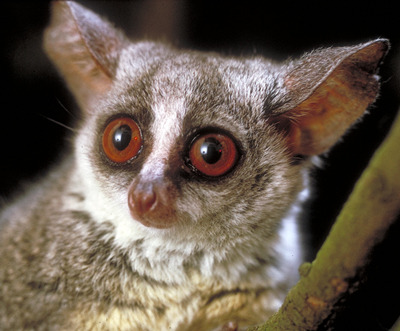

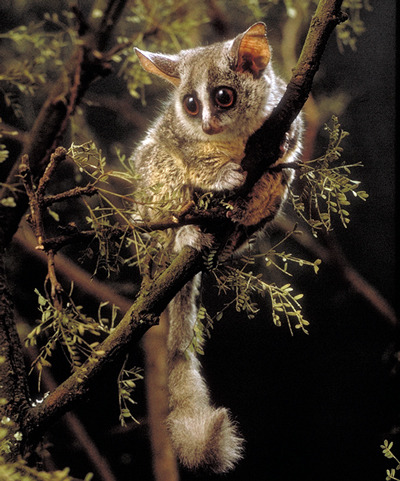
Go Go Southern Lesser Galago!
Also known as the South African galago or the mohol bushbaby, the southern lesser galago (Galago moholi) is a small primate from the Galagidae, or bushbaby family. As the name implies, they are located only in southern Africa, from northern South Africa up to Rwanda. Their preferred habitats are savannahs and semi-arid woodlands, where they can often be found high in the canopy, and they are particularly associated with Acacia trees.
The mohol bushbaby is one of the smaller members of its group; at full height they stand no taller than 15 cm (6 in) and weigh only 225 g (7.9 oz). In fact, their tail is longer than their body, easily reaching 23 cm (9 in) in length. While it isn't prehensile, the tail is still an important tool for climbing as it gives G. moholi an excellent sense of balance. Along with their incredible tails, the South African galago also has one of the largest sets of ears of any primate, proportional to its size; these ears can move independently to help the southen lesser bushbaby avoid predators. G. moholi's final distinguishing feature are their eyes, which are incredibly large and a distinctive orange color. Individuals themselves tend to be gray or light brown, which helps them blend in with their surroundings.
South African galagos are almost strictly nocturnal. At night, they forage through the canopy for moths and beetles. These bits of protein, however, are supplemental; the mohol bushbaby's primary source of food is gum, or hardened sap from the Acacia plant. G. moholi has several adaptations allowing it to specialize in gum extraction, including scraping teeth on the lower mandible; long, rough tongues; and digestive systems that have evolved to break down and ferment the tough substance. Because they have very few defense mechanisms, southern lesser galagos are a common prey for many nocturnal species like eagles, owls, snakes, mongooses, civets, and gennets.
One of the few ways the South African bushbaby avoids predation is through its social units. Groups of 2-7-- typically composed of a female, her young, and a few non-reproductive relatives-- forage together. In these groups, their collective night vision and highly-developed hearing allow them to detect and alert each other to predators long before the threat is immanent. While individuals forage seperately, they keep in contact via loud, high pitched calls that can serve as a warning for predators, a point of contact between mother and offspring, or a territorial warning between males.
Male G. moholi live seperately from social groups, and are highly aggressive against other males invading their territory. This area often overlaps that of several female-led groups, but they only come in contact with each other during the mating season. Unusually, the species has two mating seasons through the year; from January to Februrary (late summer) and from October to November (early spring). Following a gestation period of 120 days, females produce a single set of twins each mating season. Each set is weaned after approximately 3 months, and young become fully mature at 300 days. Female offspring may join the mother's group, while males leave to establish their own territory. In the wild, an individual may live up to 16 years.
Conservation status: The IUCN has classified the South African bushbaby as Least Concern. Studies have indicated that the population is stable and, in some areas, increasing. However, in other areas the species is threatened by habitat loss and possibly capture for the pet and bushmeat trade.
If you like what I do, consider leaving a tip or buying me a ko-fi!
Photos
Gerald Doyle
Peter Webb via iNaturalist
#Southern lesser galago#south african bushbaby#Primates#Galagidae#galagos#bushbabies#mammals#savannah mammals#tropical forest mammals#africa#south africa#animal facts#biology#zoology
166 notes
·
View notes
Text


once again not beating the Lesser Bushbaby allegations
43 notes
·
View notes
Text
23rd of July 2024: Southern Lesser Galago

Today’s critter has been described as a “paradox of a small mammal” [1]: the Southern Lesser Galago (Galago moholi), also known as the Moholi Galago. They’re a type of bushbaby, a small primate, and are found in the Savannah of Southern Africa. Their body is 15 cm long, though their tail is 23 cm [2].
The reason a study considered them a paradox is because usually small mammals don’t eat food that requires gut fermentation. However, often a large portion of their diet is made up the gum of the Common Acacia (Vachellia karoo), which means they need a specially adapted gut to deal with it [1], in addition to the rough, narrow tongue which helps them harvest it [2]. Certain environments may not have many acacias though, in which case they also eat the fruit of Pappea capensis. Their gut helps them here too, to fully digest the seeds [3]. They also eat insects, which they can track via their ears, which, among primates, are some of the largest proportional to body size [4].
They’re social and territorial animals, and like many primates they bond through grooming. Southern Lesser Galagos do something called urine washing, wherein they cover their hands and feet in urine, which is then transferred to the fur of others. This may also help to improve grip when moving [4]. They have two mating seasons: a primary one in May and a secondary one in late September/early October. Females prefer larger males [5].
Young Southern Lesser Galagos may, if the outside temperature unexpectedly drops, fall into a torpor, where to conserve energy, they let their body temperature drop. Unlike many other animals, this is not routine behaviour, and has been rarely observed, and not in adults [6].
Sources:
[1] [2] [3] [4] [5] [6] [Image]
3 notes
·
View notes
Text

That's All the Magic We Need
When: April 18, 2024
Where: Dierenpark de Oliemeulen Tilburg, the Netherlands
Eating in secret.
Species: Mohol or Lesser Bushbaby (Zuid-Afrikaanse galago)
Latin name: Galago Moholi
Originates from the mesic woodlands of the southern Afrotopics.
Current status: Least Concern
Did you know:
…The Mohol Bushaby is very similar to the Senegal Bushbaby, and it was actually long considered to be its southern race. However, the two species differ markedly in their biology and no hybrids have been discovered in captivity.
© Mouselemur Photography • Portegiesje
Our work is copyrighted. Do not reproduce, copy edit, publish, transmit or upload in any way without our written permission.
Send us a note or chat message if you want to use our work as a reference.
0 notes
Text
Discover the Enchantment of Lake Manyara National Park
Nestled at the base of the Great Rift Valley escarpment, Lake Manyara National Park is a hidden gem in northern Tanzania. This compact yet diverse park offers a unique blend of lush forests, sparkling lakes, and open savannahs, making it an ideal destination for wildlife enthusiasts, birdwatchers, and nature lovers. Covering approximately 330 square kilometers (127 square miles), with the lake itself accounting for two-thirds of the park, Lake Manyara National Park promises an unforgettable safari experience.

A Birdwatcher's Paradise
Lake Manyara is renowned for its impressive birdlife, with over 400 species recorded within the park. The alkaline lake attracts vast flocks of flamingos, creating a stunning pink hue against the blue waters. Birdwatchers will find endless opportunities to spot both resident and migratory species in this vibrant ecosystem.
Birdwatching Highlights:
Flamingos: Thousands of lesser and greater flamingos congregate on the lake, offering a spectacular sight.
Waterbirds: Look out for pelicans, storks, herons, and cormorants that thrive in and around the lake.
Raptors: The park is home to various birds of prey, including the African fish eagle, palm-nut vulture, and the augur buzzard.
Unique Wildlife Encounters
While Lake Manyara National Park is famous for its birdlife, it also boasts a rich array of mammal species. The park's diverse habitats support a wide range of wildlife, making every game drive an exciting adventure.
Wildlife Highlights:
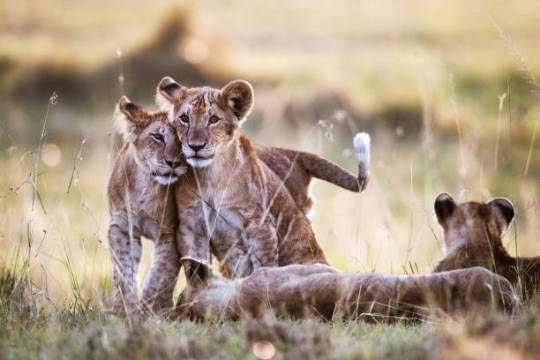
Stunning Landscapes
The scenic beauty of Lake Manyara National Park is truly captivating. The park's varied landscapes provide a picturesque backdrop for wildlife viewing and photography.
Scenic Highlights:
Great Rift Valley Escarpment: The dramatic cliffs of the Rift Valley create a stunning backdrop for the park. The escarpment rises sharply above the park, providing panoramic views of the lake and surrounding areas.
Groundwater Forests: The park's groundwater forests are lush and green, offering a stark contrast to the dry savannahs. These forests are home to a variety of wildlife and provide a cool, shady environment.
Lake Manyara: The shallow, alkaline lake itself is a focal point of the park, drawing countless birds and animals to its shores. The reflective waters create beautiful photo opportunities, especially at sunrise and sunset.
Hot Springs: The southern end of the park features hot springs, known as Maji Moto, which bubble up from the ground and flow into the lake. These geothermal features add a unique element to the park's diverse landscapes.
Safari Activities
Lake Manyara National Park offers a range of activities that cater to different interests and enhance the safari experience. Whether you’re looking for adventure or relaxation, there’s something for everyone.
Safari Highlights:
Game Drives: Explore the park on guided game drives, which are available throughout the day. Experienced guides will help you spot and learn about the park's diverse wildlife.
Night Drives: Night game drives provide a unique opportunity to see nocturnal animals in action, including leopards, bushbabies, and porcupines.
Canoeing: During the wet season, canoeing on Lake Manyara offers a peaceful way to observe birds and wildlife from the water.
Walking Safaris: Join a guided walking safari to explore the park on foot, allowing you to get closer to nature and discover the smaller details often missed on game drives.
Cultural Visits: Engage with the local communities around the park, including the Maasai and Mbugwe tribes, to learn about their traditional ways of life and cultural heritage.

Accommodation Options
Lake Manyara National Park offers a range of accommodation options to suit different budgets and preferences. From luxury lodges to budget-friendly campsites, there’s something for everyone.
Where to Stay:

Conclusion
Lake Manyara National Park is a hidden gem that offers a unique and rewarding safari experience. With its abundant birdlife, diverse wildlife, and stunning landscapes, it is a destination that should not be missed. Whether you’re a first-time visitor to Tanzania or a seasoned safari-goer, Lake Manyara promises an unforgettable adventure filled with remarkable sights and experiences. So pack your bags, bring your binoculars, and get ready to explore one of Tanzania’s most enchanting national parks.
#tourist#ugandian knuckles#tourism#wild animals#tour#Adventure#photography#beach#safari#africa#Nairobi#Uganda#Kenya#Masai Mara#beaches#Wanderlust#east africa#Travel Photography#travel blog#tanzania#tanned#zanzibar#tangled#tanzanite#kenyan#kenya moore#beachlife#Kenya Safari#Nairob#travel
0 notes
Photo

Lesser Bushbaby
By Dean Polley
3 notes
·
View notes
Photo






Spider-Man: Far From Home (2019) / The Lion King (2019)
#spidermanffhedit#lionking19edit#spider-man far from home#peter parker#the bus scene#the lion king#galago lesser bushbaby#lesse bushbaby#filmgifs#moviegifs#bbelcher#disneyanimationdaily#animationdaily#dailycinema#filmdaily#doyouevenfilm#ruinedchildhood#userstream#thegifs#mygifs#filmedit
100 notes
·
View notes
Text

Lesser bushbaby and squirrel monkey skull.
97 notes
·
View notes
Photo
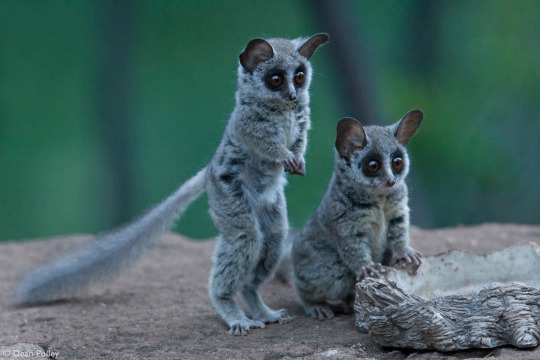
Bushbabies – The Southern Lesser Galago - Africa Geographic.
How extremely cute <3 <3
3 notes
·
View notes
Link
Here is a fun video of a dwarf lemur (although some people say it's a lesser bushbaby) discovering a strawberry.
When you sign up for a Publish0x account, you can leave a cryptocurrency tip for this and other posts that you enjoy at no cost to yourself and get tips for your posts too!
https://www.publish0x.com?a=9wdL33wbjP
1 note
·
View note
Photo

It's been a day of Native American culture for me. First I visited the art exhibit at the campus museum featuring contemporary Native American art, then I downloaded a dozen Native American mods for Civ 6 (and played for hours as the Cheyenne); now I drew a primate with a Native American name. Ekwiiyemakius walshi was described last year by Amy Atwater; its name honors palaeontologist Stephen Walsh, and "Ekwiiyemak" (behind the clouds) references the Kumeyaay peoples' name for the Cuyamaca region of California. I went with an appearance here that is based off several related omomyids as well as modern tarsiers and other small basal primates. There's nothing more to this taxon than teeth; luckily, mammalian teeth are highly distinctive and are actually worth a scientific name most of the time. And of course, this tiny guy (about 120g, or the size of a lesser bushbaby) is sitting in a ginkgo tree, because I like ginkgoes.
#ekwiiyemakius#primate#omomyid#omomyidae#primates#eocene#california#cuyamaca#ekwiiyemak#paleontology#palaeontology#paleoart#palaeoart#palaeoblr#paleoblr#paleo#prehistoric#palaeo#prehistory#prehistoric mammals#cenozoic#drawing#traditional art#pencil
27 notes
·
View notes
Photo

Lesser bushbaby that can be seen in Crocodile bridge camp mainly in the winter months as they sleep in the fence poles. https://www.kruger-2-kalahari.com/ #Kruger2Kalahari #NaturePhotography #WildlifePhotography #PhotoSafari #nikonwildlife #knp #KrugerPark #krugernationalpark #greaterkruger #kruger #krugerexplorer #krugersafari #krugerparksafari #krugerselfdrive #travelphotographer #selfdrivesafari #bigfivesafari #bushbaby #lesserbushbaby #crocodilebridge (at Kruger National Park, Mpumalanga) https://www.instagram.com/p/CirGlGNKPNr/?igshid=NGJjMDIxMWI=
#kruger2kalahari#naturephotography#wildlifephotography#photosafari#nikonwildlife#knp#krugerpark#krugernationalpark#greaterkruger#kruger#krugerexplorer#krugersafari#krugerparksafari#krugerselfdrive#travelphotographer#selfdrivesafari#bigfivesafari#bushbaby#lesserbushbaby#crocodilebridge
0 notes
Photo
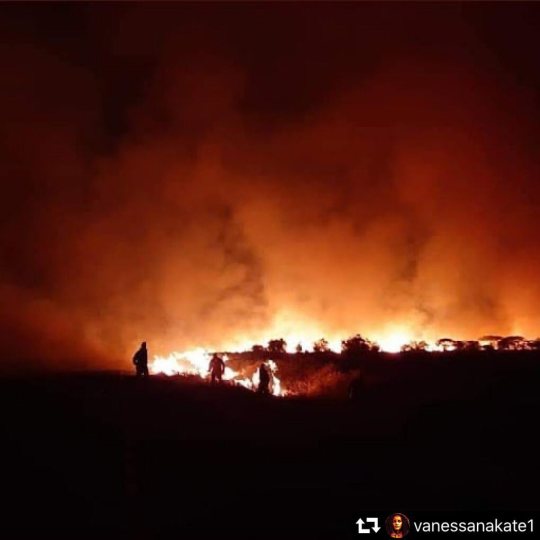
Repost from @vanessanakate1 🔥Tsavo National Park in Kenya is on fire、we don't see any media coverage。 Alert people about what is happening。It has been burning and these are the animals in danger:the aardwolf、yellow baboon、bat、Cape buffalo、Senegal bushbaby、bushbuck、caracal、African wildcat、southeast African cheetah、African civet、Kirk's dik-dik、African wild dog、African dormouse、blue duiker、bush duiker、Harvey's red duiker、common eland、African bush elephant、bat- eared fox、northern greater galago、Grant's gazelle、rusty-spotted genet、common genet、gerenuk、giraffe、African savanna hare、springhare、Coke's hartebeest、Hunter's hartebeest、East African hedgehog、spotted hyena、striped hyena、yellow-spotted rock hyrax、southern tree hyrax、impala、black-backed jackal、side striped jackal、klipspringer、lesser kudu、leopard、lion、banded mongoose、dwarf mongoose、Egyptian mongoose、marsh mongoose、slender mongoose、white-tailed mongoose、vervet monkey、Sykes 'monkey、fringe- eared oryx、clawless otter、ground pangolin、crested porcupine、cane rat、giant rat、naked mole rat、honey badger、bohor reedbuck、black rhinoceros、serval、elephant shrew、bush squirrel、East African red squirrel、striped ground squirrel、unstriped ground squirrel、suni、common warthog、ellipsen waterbuck、plains zebra and Grevy's zebra。Over 500 bird species are also in danger such as ostriches、kestrels、buzzards、starlings、weaver birds、kingfishers、hornbills、secretary birds and herons. Daring local media and international media to report about this and see how the fires can be stopped。If you have resources on how people can help、please share here。And for the rest of us、please share any tweets or posts about the fires in Tsavo National Park . . . #fire #2020 #help #kenya #kenyafire #govegan #sosplanet #sosearth #earth #earthlings #earthling #pleaseshare https://www.instagram.com/p/CDteXE8n_lm/?igshid=xuff4kprf8es
0 notes